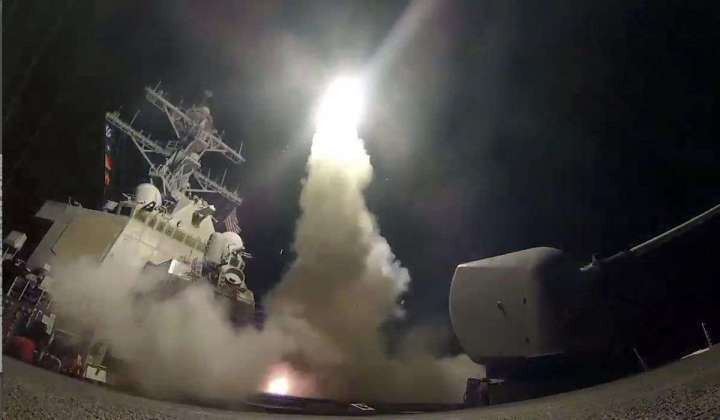North Korea’s Kim Jong-un signals a new focus on beefing up navy

SEOUL — North Korean leader Kim Jong Un staged war games this week that culminated in tactical nuclear strikes and the conquest of South Korea, the country’s state-controlled media reported, while also calling for an unexpected upgrade of the country’s naval capabilities.
Pyongyang‘s latest move comes as regional powers in the Indo-Pacific, including Australia, China, India and Japan, have all been investing massively in maritime “blue” assets.
Seas off the Korean peninsula are “the most unstable waters with the danger of a nuclear war,” Mr. Kim reportedly told his naval commanders. “Rapidly developing the naval force has become a very urgent issue in view of the enemies’ recent aggressive attempts and character of military actions.”
But analysts question whether poverty-struck North Korea, already saddled with heavy investments in its nuclear and missile forces, can afford the stronger navy its leader covets.
Even so, Pyongyang has good reasons to improve maritime capabilities, which could make its nuclear deterrent more secure and possibly open up opportunities to drill with Russian warships.
“They stopped investing in their navy for such a long time that it has deteriorated and is probably the least capable in the region,” said Go Myong-hyun of Seoul’s Asan Institute, a think tank. “Unlike beefing up the air force, beefing up the navy has tangible and immediate benefits for North Korea.”
SEE ALSO: North Korea claims test of Russia-style unmanned underwater nuke
Mr. Kim oversaw exercises run by the country’s General Staff on Tuesday, according to reports Thursday in the North Korean state media. The drills “aimed at occupying the entire territory of the southern half [of Korea] by repelling the enemy’s sudden armed invasion and switching over to an all-out counterattack,” the reports said.
The exercises encompassed tactical nuclear strikes and the destruction of U.S. and South Korean command centers.
South Korean and American forces have been conducting 10 days of the summertime “Ulchi Freedom Shield” joint exercises, which started on August 21. For the Korean peninsula, the dueling drills are business as usual.
“The Command Post exercise is nothing new in that they are relying on the same scenario as they did in 1950,” said David Park, a retired US Army officer with wide experience on the peninsula. “It is likely that Kim is merely exercising and showing off … for domestic and international gain in terms of prestige and reputation.”
But the North’s new naval tilt has raised eyebrows among South Korean and Western analysts.
On August 21, Mr. Kim visited a flotilla on North Korea‘s east coast, overseeing a patrol vessel as it fired a “strategic” cruise missile, and earlier this week, the North Korean leader met with cheering officers of the Naval Command together with his daughter Ju Ae.
Mr. Kim reported told his admirals that the North’s navy must become nuclear-capable. In fact, in March, Pyongyang tested a giant underwater drone armed with a nuclear warhead, and claims to have tested underwater ballistic missile launched from a submarine.
Under Mr. Kim‘s father and grandfather, the North Korean navy lagged behind the ground-based military assets and the country’s elaborate intelligence operations when it came to funding. But regional events — and major naval upgrades by China, Japan, Australia and India — are apparently pushing the current North Korean leader in a new direction.
Ironically, South Korea has been the odd man out so far in the East Asia maritime arms race. Though it has proven domestic ballistic missile submarine capabilities and helicopter carriers, Seoul has put plans for light carriers on hold.
Still, it fields a more high-tech force than the North’s decrepit navy, whose patrol boats have manually-rotated gun turrets, compared to the South’s electrically operated miniguns, said Chun In-bum, a retired general. Even with greater investments, Mr. Kim can hardly expect to build a fleet that can match the South Korean and U.S. navies in an all-out war, analysts said.
“They’d need the capacity to build bigger ships with stealth technologies and new weapons,” said Oleg Kiriyanov, CEO of Seoul-based think tank Asia Risk Research Center. “Frankly, that is very expensive, so I don’t think so.”
But there are some clear payoffs: for one, light naval forces can conduct hit-and-run, coastal attacks without sparking an all-out war.
“If you are thinking about incremental escalations, naval clashes solve that,” said Mr. Go. “We have seen them in the Yellow Sea, and this is exactly the kind of escalation that solves North Korea’s strategic purpose of keeping the initiative by raising tensions.”
Furthermore, deploying nuclear arms at sea makes it harder for adversaries to take out Pyongyang’s nuclear programs, while potentially extending their range in a crisis.
“Putting them on submarines and ships gives them additional capabilities, of course: range and survivability,” said Mr. Kiriyanov.






